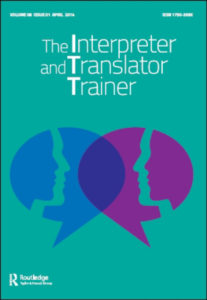[CFP] Translation Technology Teaching: Views and Visions
 The Interpreter and Translator Trainer
The Interpreter and Translator Trainer
Special Issue Editor(s)
Youlan Tao, Fudan University, China
taoyoulan@fudan.edu.cn
Huashu Wang, Guangdong University of Foreign Studies, China
wanghuashu@gdufs.edu.cn
In the era of Artificial Intelligence, the rapid developments in translation technology have exerted significant impact on translator education and translation industry, which puts translation technology teaching on the agenda of tertiary education. In recent years, universities and colleges have started to include translation technology in their curriculum and gained experience in the teaching of this subject. However, teachers are increasingly faced with challenges on how to teach translation technology more effectively and how to integrate technology into other translation courses.
New technologies such as neural machine translation, automatic speech recognition, video remote interpreting, cloud-based translation and content automation have been widely used in the language service industry, which calls for more translators and interpreters with strong technological competence. In order to meet the demands of translation markets, it is necessary for universities and colleges to cultivate students’ technological competence and develop their information literacy by strengthening translation technology teaching. Therefore, issues about translation technology teaching competence, teacher training and certification, teaching methodology, teaching resources and tools, curriculum design, evaluation and testing methods are all to be discussed and investigated theoretically and practically.
In this special issue we want to bring to the fore these and other translation technology-related issues that need to be addressed by translation trainers, translation researchers and technology providers. We hope that the investigation of such issues can contribute to the translator (and interpreter) research-informed education.
Themes that may be addressed include (but are not restricted to) the following:
- Translator and interpreter education driven by technology in the era of AI
- Theoretical and pedagogical aspects of translation technology teaching
- Innovations and collaboration in translation technology teaching
- Improving students’ humanistic literacy in translation technology teaching
- Cultivating teachers’ translation technology teaching competence
- Developing students’ translation technological competence
- Information literacy development for student translators and interpreters
- Exploring effective methodologies for technology teaching
- Exploring the integration of technology into translation curriculum
- Technology teaching resources and textbook development
- Empirical studies on technology teaching models
- Training of translation technology teachers
- Curriculum and syllabus design for the future: good practices in training and research collaboration among translation scholars/trainers, computational linguists and IT experts in industry settings.
Submission Instructions
We invite original, up-to-date, research-based contributions that do not exceed 8000 words (tables, captions, references, footnotes and endnotes included) and that reach out to an international readership. Although there is room for exploratory research, contributions that report on completed research will be given priority. All papers will be subject to double-blind peer review. The focus of all submissions should be in line with the ITT aims and scope:
www.tandfonline.com/action/journalInformation?show=aimsScope&journalCode=ritt20
Abstracts (500 words) should be submitted to the guest editors by 20 January 2021.
Schedule for publication
| 20 Jan 2021: | Deadline for the submission of abstracts (500 words) |
| 20 Feb 2021: | Selected contributors notified of the provisional acceptance of abstracts |
| 20 June 2021: | Deadline for the submission of full papers |
| June 2021– end September 2021: | First round of peer-review |
| Oct 2021: | Notification of the outcome of the first round of peer-review; papers short-listed for provisional acceptance |
| Oct 2021–Jan 2022: | Authors submit revised versions; second round of peer-review where necessary |
| 1 Feb 2022: | Deadline for submission of final versions of papers |
| 1 April 2022: | Final editing and proofreading |
| June 2022: | Publication |
For more details, please visit: https://think.taylorandfrancis.com/special_issues/translation-technology-teaching-views-and-visions/?utm_source=TFO&utm_medium=cms&utm_campaign=JPG15743
